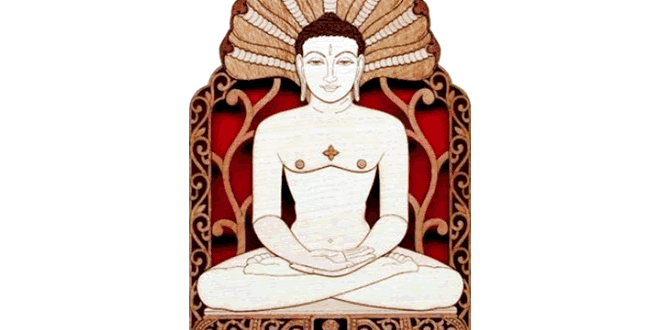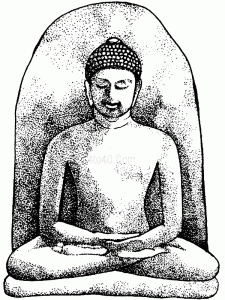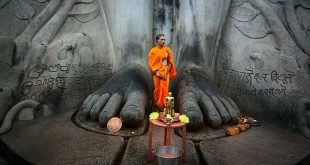नवकार मंत्र: Navakar Mantra
The Ṇamōkāra Mantra (णमोकार मन्त्र), also variously referred to as the Navakar Mantra (नवकार मन्त्र), Namaskār Mantra (नमस्कार मन्त्र) or the Pancha Parameshti Namaskār, is the most significant mantra in Jainism.
Jain Prakrit
णमो अरिहंताणं
णमो सिद्धाणं
णमो आयरियाणं
णमो उवज्झायाणं
णमो लोए सव्व साहूणं
एसोपंचणमोक्कारो, सव्वपावप्पणासणो
मंगला णं च सव्वेसिं, पडमम हवई मंगलं
Transliterated to English
Ṇamō Arihantāṇaṁ
Ṇamō Siddhāṇaṁ
Ṇamō Ayariyāṇaṁ
Ṇamō Uvajjhāyāṇaṁ
Ṇamō Lōē Savva Sāhūṇaṁ
Ēsōpan̄caṇamōkkārō, savvapāvappaṇāsaṇō
Maṅgalā ṇaṁ ca savvēsiṁ, paḍamama havaī maṅgalaṁ
नवकार मंत्र: हिंदी अनुवाद
मैं अरिहंतों को नमन करता हूँ ।
मैं सिद्धों को नमन करता हूँ ।
मैं आचार्यो को नमन करता हूँ ।
मैं उपाध्याओ को नमन करता हूँ ।
मैं लोक (जगत्) के सर्व साधुओ को नमन करता हूँ ।
ये पाँच नमन के उच्चार, सभी पापो का पूरा नाश करते हैं ।
और, सभी मंगलों में, यह बिलकुल प्रथम मंगल हैं ।
नवकार मंत्र: English Meaning
Namah Arihantanam — I bow to the Arihants, the Conquerors.
Namah Siddhhanam — I bow to the Siddhas, the Liberated ones.
Namah Ayariyanam — I bow to the Acharyas, the Preceptors.
Namah Uvjhayanam — I bow to the Upadhyays, the Teachers.
Namah Loye Savva Saahunam — I bow to all the Sages of the world.
Aiso Panch Namahkkaro — This five-fold salutation (mantra)
Savva Paav Panasano — completely destroys all the sins and obstacles.
Manglanancha Savvesim — And, of all auspicious mantras,
Padhmam Havei Mangalam — (it) is indeed the foremost auspicious one.
Tamil
அருகரை வணங்குகிறேன்;
சித்தரை வணங்குகிறேன்;
ஆசாரியரை வணங்குகிறேன்;
உபாத்தியாயரை வணங்குகிறேன்;
சாதுக்கள் எல்லாரையும் வணங்குகிறேன்;
இந்த ஐவர் வணக்கம் எல்லா தீமைகளையும் ஒழிப்பது.
இம் மங்கலம் எல்லா மங்கலங்களிலும் முதன்மை ஆனது.[7]
Kannada
ಓಂ ಣಮೋ ಅರಿಹಂತಾಣಂ
ಣಮೋ ಸಿದ್ಧಾಣಂ
ಣಮೋ ಆಯರಿಯಾಣಂ
ಣಮೋ ಊವಜ್ಜಾಯಾಣಂ
ಣಮೋ ಲೋಯೆ ಸವ್ವ ಸಾಹೂಣಂ
ಯೆಸೊ ಪಂಚ ನಮೊಕಾರೋ ಸವ್ವ ಪಾವ ಪಣಾಸಣೋ
ಮಂಗಳಾಯ ಚ ಸವೆಸಿಮ್, ಪಡಮಮ್ ಹವಹಿ ಮಂಗಳಂ
English
Namo Arihantanam
Namo Siddhanam
Namo ayariyanam
Namo Uvajjhayanam
Namo Loe Savva sahunam
Esopancanamokkaro, savvapavappanasano
Mangalanam cha savvesim, padamama havai mangalam
The Ṇamōkāra Mantra (णमोकार मन्त्र) is the first prayer recited by the Jains while doing Samayik. While reciting this mantra, the devotee bows with respect to the Panch Parameshti (the Supreme Five) in the order of their sanctity of soul. The Navkar Mantra is the most important mantra in Jainism and can be recited at any time. While reciting the Navkar Mantra, we are bowing down with respect to Arihantas (souls who have reached the state of non-attachment towards worldly process), Siddhas (liberated souls), Ächäryäs (heads of sadhus and sadhvis), Upädhyäyas (those who teach scriptures to sadhus and sadhvis), Sädhus (monks, who have voluntarily given up social, economical and family relationships) and Sädhvis (nuns, who have voluntarily given up social, economical and family relationships). Collectively, they are called Panch Parmesthi (five supreme spiritual people). In this mantra, we worship their virtues rather than worshiping any one particular person; therefore, this Mantra is not named after Lord Mahavir, Lord Parshvanath or Adinath, etc. When we recite Navkar Mantra, it also reminds us that we need to be like them. This mantra is also called Namaskär or Namokär Mantra because we are bowing down.
The Navkär Mantra contains the main message of Jainism. The message is very clear: if we want to be liberated from this world, then we have to take the first step of renunciation by becoming a monk or a nun. This is the beginning. If we stay on the right path then we will proceed to a higher state, Arihant, and ultimately proceed to Siddha after nirvana (liberation from the cycle of birth and death). The goal of every Jain is, or should be, to become a siddha.
They are as follows:
- Those who have cleared their gati karmas (arihants)
- The fully liberated souls (siddhas)
- The spiritual leaders or Preceptors (acharyas)
- The teachers (upajjhayas)
- The monks or sages in the world
There is no mention of any particular names of the gods or any specific person. The prayer is done towards the ‘guna’ (the good qualities) of the gods, teachers and the saints. Jains do not ask for any favors or material benefits from the Tirthankaras or from sadhus. This mantra simply serves as a gesture of deep respect towards beings whom they believe are spiritually ahead, as well as to remind the people of their ultimate goal of nirvana or moksa.
Digambaras and Sthanakvasis regard the first five lines as the main mantra. The following two lines are meant to explain the benefit of reciting the mantra.
 Kids Portal For Parents India Kids Network
Kids Portal For Parents India Kids Network








